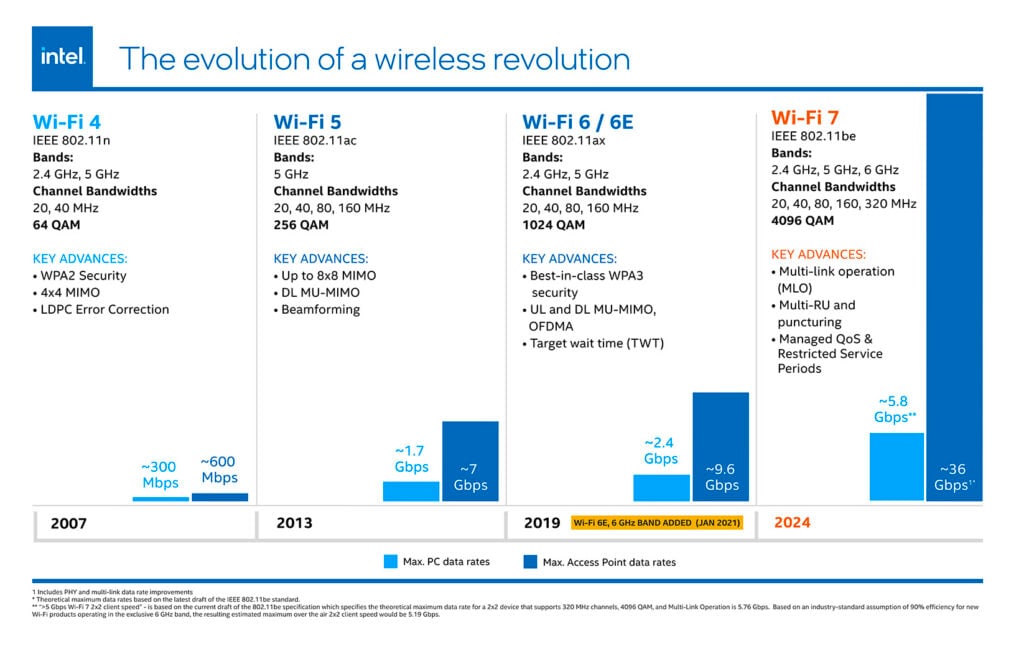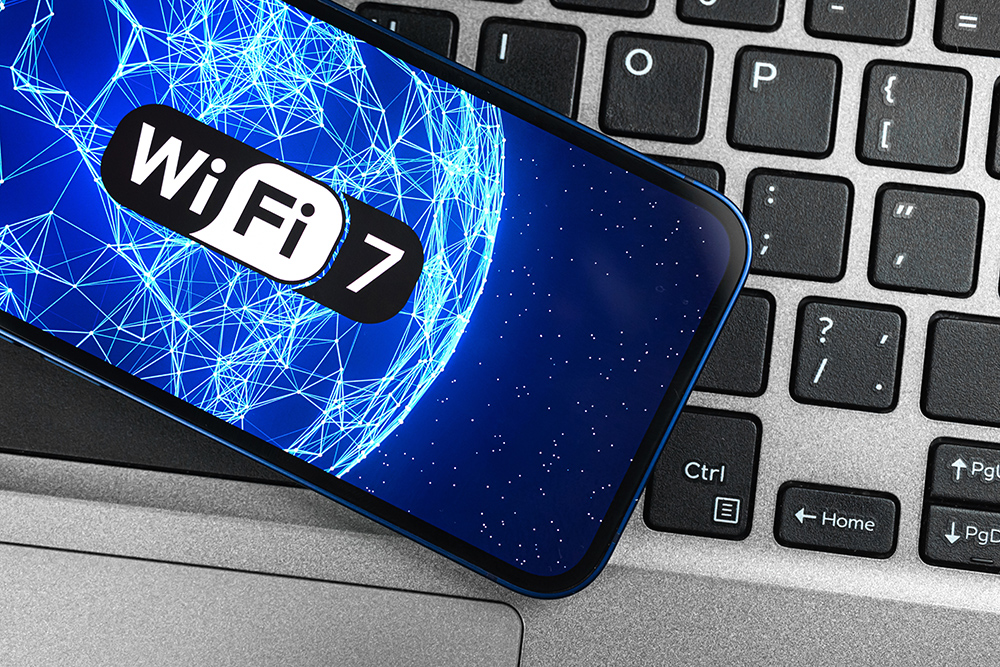WiFi 7 (also known as 802.11be) is one of the biggest improvements in wireless networking for years. First released in 2024, WiFi 7 introduces faster speeds, lower latency, more bandwidth, and other groundbreaking features. Here’s everything you need to know about WiFi 7, how fast it really is, and if you should upgrade your router yet.
How Fast Is WiFi 7?
A WiFi 7 router can theoretically achieve speeds of 46 Gbps (gigabits per second), but you’ll only get a maximum of 5.8Gbps delivered to your connected devices in reality. Still, that’s around 2.4 times faster than WiFi 6 and WiFi 6E, which could only achieve real-world speeds up to 2.4Gbps.
Read More: What is WiFi 6E?


The 6GHz Highway
For many years, WiFi routers usually only transmitted data using two different radio frequency bands: the older and slower 2.4GHz (gigahertz) band, and the newer and faster 5GHz band. In 2020, the FCC opened up a new 6GHz WiFi band, which is bigger and faster than both previous bands combined.
To make things simple, you can think of the 6GHz WiFi band almost like a brand-new 59-lane superhighway with almost no traffic.
Read More: What’s the difference between 2.4GHz and 5GHz?
One reason the 6GHz highway is still so empty, however, is because not many devices are compatible with the technology yet. While a WiFi 7 router will work with older devices on the 2.4GHz and 5GHz bands, you shouldn’t expect to see significant differences until you upgrade your devices first.
320MHz Ultra-Wide Channels
Each WiFi band is split up into channels, almost like separate lanes on a highway. With WiFi 7, you’ll be able to connect compatible devices to three new ultra-wide lanes. These new 320MHz (megahertz) channels provide twice as much bandwidth as the widest channels on the previous standards.
The three new 320MHz channels were designed to ensure there is enough bandwidth for activities like VR gaming, 8K video streaming, and other future technologies.
In total, the 6GHz band provides twice as much spectrum as the 2.4Ghz and 5Ghz networks combined, and you won’t have to worry about connecting to “restricted” channels. Previously, WiFi signals could be intermittently blocked by radar systems (from the government, military, and weather stations) when connected to DFS (Dynamic Frequency Selection) channels. Because of this, the DFS channels are rarely used, and the few remaining 80MHz and 40Mhz channels are often overcrowded.
Read More: How to change channels on your WiFi router
In total, the 2.4GHz and 5GHz bands only provide 260MHz of unrestricted spectrum, compared to the 1,200MHz of unrestricted spectrum on the 6GHz band. So, WiFi 7 has multiplied the number of usable lanes to connect to the internet by a factor of five, making it one of the biggest upgrades to WiFi ever.
Multi-Link Operation
Until now, you could only connect devices to one WiFi band at a time. With MLO (multi-link operation), WiFi 7 devices will now be able to connect to multiple bands simultaneously. By sending data concurrently or redundantly across two or more bands, MLO makes WiFi 7 faster and more reliable.
In the past, when WiFi bands became congested, you would either have to struggle with slower speeds or manually change to a different band. With WiFi 7, your devices can automatically switch bands as easily as a car switching lanes on a highway. Basically, MLO is like combining all your WiFi bands into a single highway.
A WiFi 7 router can also send redundant data on two bands, like two different trucks carrying the same load on two different highways to ensure it gets there as fast as possible. Alternatively, a WiFi 7 router can prioritize the most important data for the fastest band, like a trucking company that uses the fastest routes for top-priority packages.
However, devices made for WiFi 6E and earlier standards won’t work with MLO, and you will only be able to connect to a single band at a time. But even if you don’t upgrade your devices for a while, MLO will still help strengthen the connection in a mesh WiFi system, so you can expand your network to every room in your home.
Read More: What is mesh WiFi?
4K-QAM
With 4K-QAM (Quadrature Amplitude Modulation), a WiFi 7 signal can transmit about 20% more data compared to WiFi 6 or WiFi 6E. To make things simple, a WiFi 7 router can convert more bits of data into each radio wave, almost like a more efficient trucking company that loads more boxes into each truck.
Multi-RU and Puncturing
In the past, an entire WiFi channel could be interrupted or blocked by a single connected device. With Multi-RU and Preamble Puncturing, a WiFi 7 router can now carve up a WiFi channel and take advantage of the remaining bandwidth that is not being used by that device.
Together, these technologies help allocate data more efficiently, which reduces latency by up to 25% compared to WiFi 6. So, you should experience less buffering when loading web pages, streaming videos, or making video calls.
Is WiFi 7 Backward Compatible?
WiFi 7 routers are backward compatible, and almost all your devices should still work when you upgrade. However, most WiFi 7 routers will require you to use WPA2 security when connecting devices to the 2.4GHz and 5GHz networks or WPA3 security when connecting to the 6GHz network.
If your devices aren’t compatible with these new security standards, you might not be able to connect them and secure your network at the same time. However, that would only matter if you’re still using an old gen-1 WiFi 5 router made before 2013.
Is WiFi 7 Worth It Yet?
As long as you are currently using a WiFi 5 or WiFi 6 router, it might not be worth upgrading just yet. To be sure, upgrading your router will improve your network, but the real benefits are largely wasted unless you have a few WiFi 7 compatible devices, which won’t be mainstream for a while.



